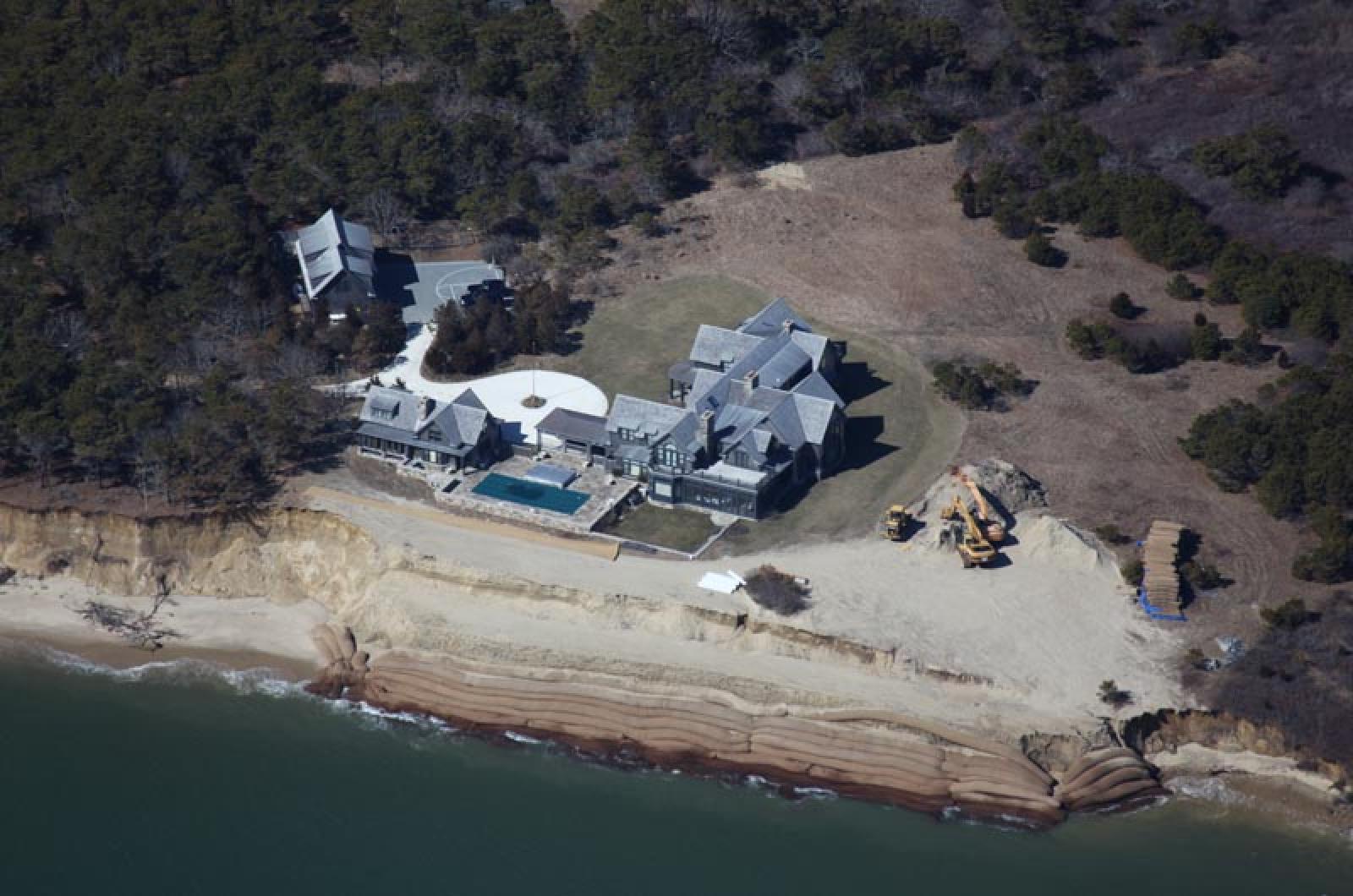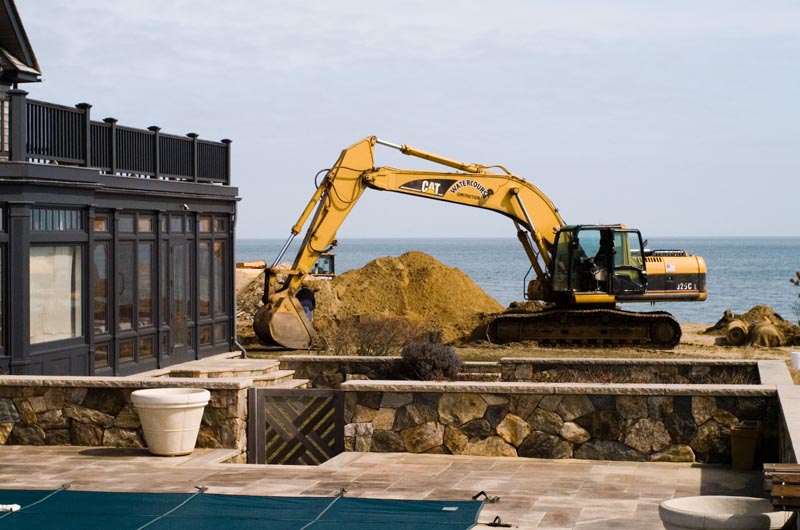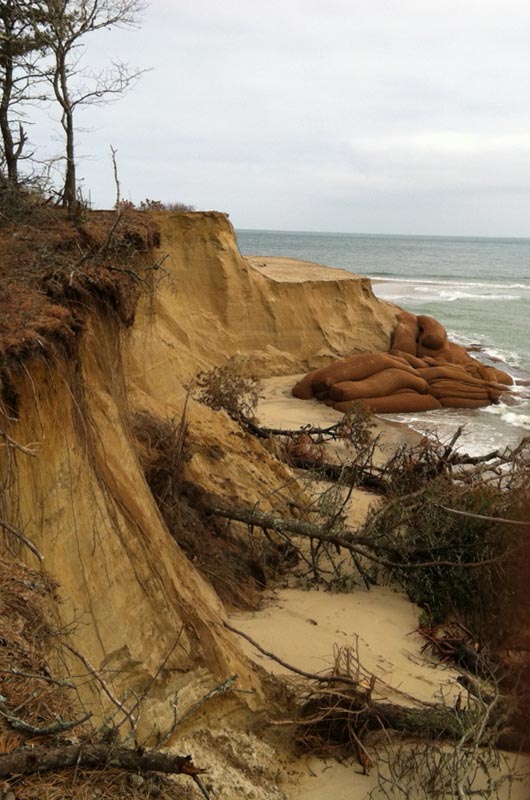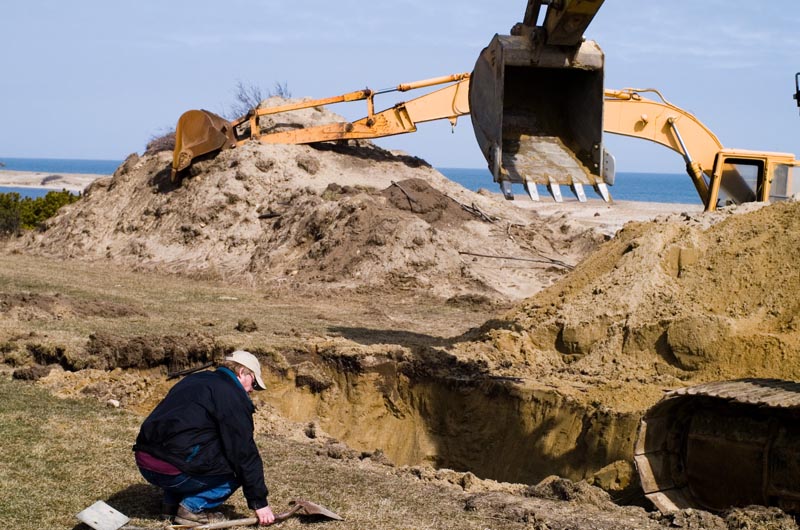Plans to move a Chappaquiddick home threatened by erosion became more urgent this week, after last week’s nearly-three-day storm brought the coastal bank 11 feet closer to Richard and Jennifer Schifter’s Wasque Point home. But as waves continue to eat away at the waterfront property, the drama of the house move has extended into now weekly meetings at Edgartown town hall, where the house faces regulatory, logistical, and environmental concerns from town officials and neighbors.
The project needs the approval of the planning board and the conservation commission, which held a three-hour meeting this week before postponing the matter. The Wampanoag Tribe of Gay Head (Aquinnah) has said it would like to review the top layer of soil to look for burial artifacts. In an added wrinkle to the plans, the Martha’s Vineyard Commission Wednesday said the project counts as a modification of an existing development of regional impact and needs commission review.
These are just the latest developments in a complicated, oft-changing project to move the 8,800-square-foot home at Wasque Point, along with a guest house, a garage, sewering, utilities and a swimming pool. The Schifters purchased a neighboring house and property from the Leland family; the so-called Leland house will also be moved to make way for the relocated main house.
When construction finished on the home in 2007, it was 220 feet away from the coastal bluff. Yesterday, engineer George Sourati, who is working on behalf of the Schifters, reported that the Atlantic Ocean is now 24 feet away from a stone wall around the swimming pool, and 39 feet away from the guest house. Commissioners approved a plan at the meeting to repair a coir envelope system, coconut fiber material filled with sand, that is intended to stanch the erosion but has recently started to fail. Commissioners said the envelopes could stay in place until the house move is complete.
About 20 people packed into the second floor meeting room Wednesday at Edgartown town hall where Mr. Sourati was joined by experts from International Chimney Company which is overseeing the house move, soil and landscape experts, architects, and coastal geologists were peppered with questions from the commission.
Last week, the planning board approved plans to move the Leland house, but cited several concerns about the rest of the project, including the number of trips required to haul soil from the property to other storage sites on Chappaquiddick. An estimated 4,000 trips on the Island roads was a cause of concern for planning board and audience members. The issue was again addressed before the conservation commission meeting, which had most of the planning board in attendance.
“We heard from everyone loud and clear,” Mr. Sourati said about that matter, and the plan now is to truck top soil worth saving, plus some native trees and plants, to off-site locations on Chappaquiddick. But most of the soil, he said, would be stored on-site instead of at secondary locations.
He said some 5,800 cubic yards of soil would need to be disposed of at the end of the project, and they are hoping some of that can be used for beach nourishment. “We’re trying to minimize as much as possible traffic on the road in Chappaquiddick,” he said, by cutting the number of trips down from 4,000 to 600.
Concerns about how the house move would alter the landscape at Wasque Point, a remote area where The Trustees of Reservations are stewards for most of the land, were also addressed, with an architect showing views from the Dike Bridge in which the houses were less visible than they are now.
Chris Kennedy, the Martha’s Vineyard superintendent for The Trustees of Reservations, said he was reassured by the reduction in traffic trips and the viewshed images, though he still wants final illustrations of the view from Trustees property and would like to work to mitigate as much as possible the impact between truck traffic and pedestrians and bicyclists.
Chappaquiddick resident Woody Filley asked if the site would be secured. Mr. Sourati said it would, with a chain link fence around the site and individual fences around the excavation sites.
“This is probably one of the largest projects we’ve seen on Chappaquiddick, and maybe Edgartown,” Mr. Filley said, noting it would take a lot of conservation agent Jane Varkonda’s time. “This is setting a benchmark for the future where people are probably going to want to push the limits here.”
“Also, this land disappears fast,” he said, questioning whether the move would offer a long-term solution. “What are some of the assurances, and at what point do you say uncle?”
In the last four years, Mr. Sourati said, the property has lost almost 200 feet of bluff. The new location is 275 feet away from the bluff.
“Could this possibly be a tremendous waste of money?” commission chair Edward Vincent asked Mr. Sourati.
Mr. Sourati said there were no assurances the plan would save the house in the long term, but said Mr. Schifter is comfortable that the plan is the best course of action.
Planning board member Robert Sparks said most of his concerns were assuaged at the meeting, except for one point. Plans call for the main house to be moved with the basement intact, and he wondered if rebuilding the foundation instead of moving it might call for less disturbance at the site.
Mr. Sourati said the house has to be moved through excavation regardless, and said it would be easier to move the entire structure with the substantial basement, which has a bowling alley and a movie theatre, attached.
Removing the foundation would require about eight feet less of digging, he said, but would yield about 330 yards of concrete, which would require about 150 trips to remove from the site.
When it came down to a decision, Mr. Sourati urged the commission to act quickly. “I think we desperately need to get going,” he said.
He told the conservation commission that pending approval, a barge with construction materials would be shipped from Maryland to Chappaquiddick and could arrive the first week of April. The entire process is expected to take four months, not including the time it will take to restore the former home site to open space.
Conservation commission member Stuart Lollis said he was ready to act, and made a motion to approve the project. “I’m in a spirit of agreement,” he said. “We’ve kicked this can down the road for a long, long time. From my point of view I think I’ve got enough information.”
But Ms. Varkonda and commission members were more hesitant, saying the issue was unprecedented and some information was newly presented to the commissioners. Ms. Varkonda noted the application to move the house was filed two weeks prior.
“I’m not all warm and fuzzy about this,” commissioner Jeffrey Carlson said. “This project has been hurry-up-and-wait by the applicant as much as by us. I understand the urgency of the house . . . I don’t understand why a couple of weeks makes a difference.”
“All the board members want to see this project happen,” commissioner Christina Brown said, saying she thought the application would likely be approved. However, she said, the commission needed more information.
In the end the commission scheduled a special meeting for Monday, March 18 at 1 p.m. to continue the matter.
The Martha’s Vineyard Commission adds another regulatory wrinkle. Last week the planning board briefly discussed whether to refer the project to the commission and decided not to take that action. But in a March 13 memo to the Edgartown planning board, conservation commission and building inspector, commission executive director Mark London said the Leland subdivision, which is part of the land purchased by the Schifters, was a development of regional impact and modification of that land would require review by the commission.
Specifically, Mr. London said, there will be five houses in the area covered by the original decision, instead of the four approved, and the lot line will be altered. He pointed out that the review will only require a public hearing if the commission determines the changes have enough of an impact to warrant one, and that the commission looks at the town’s review process in making that decision. “The considerable efforts of Edgartown boards and their consultants in addressing the Schifter project would presumably weigh in the Commission’s determination,” he wrote.
“The Commission understands that the applicant and Town are anxious to deal with this proposal as rapidly as possible,” he continued, pointing out that last fall, the commission expedited a decision to allow the Leland lot sale to the Schifters. He said that if the project is quickly referred to the commission, it could be on the agenda for next week’s land use planning committee and commission meetings.
“It is in everyone’s interest, including that of the landowner, to ensure that all required procedures are followed in order to avoid any unnecessary delays in the permitting of the proposal, any potential challenges to such permits, or any issues that may arise in the event of future resale.”
As of Thursday afternoon, MVC development of regional impact coordinator Paul Foley said the issue had not been referred to the commission. If the issue is not referred by a town official, the commission’s compliance committee could review the matter and make a determination.









Comments (6)
Comments
Comment policy »